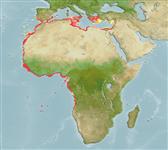Environment: milieu / climate zone / depth range / distribution range
Ecologia
marinhas; estuarina demersal; oceanódromo (Ref. 51243); intervalo de profundidade 20 - 200 m (Ref. 3589). Subtropical; 39°N - 16°S, 17°W - 60°E (Ref. 54435)
Eastern Atlantic: along the west coast of Africa to southern Angola (Ref. 5222, 57293), including the southern Mediterranean (Ref. 5222). First record from Corsica, France in 2012 (Ref. 95840). Records from the Canary Islands and Cape Verde are unsubstantiated (Ref. 5222).
Comprimento de primeira maturação / Tamanho / Peso / Idade
Maturity: Lm 55.0, range 50 - 60 cm
Max length : 120 cm TL macho/indeterminado; (Ref. 5222); common length : 60.0 cm TL macho/indeterminado; (Ref. 26999); peso máx. publicado: 25.0 kg (Ref. 5222)
Espinhos dorsais (total) : 10 - 11; Raios dorsais (total) : 14 - 16; Espinhos anais: 3; Raios anais : 7 - 9. Diagnosis: depth of body less than head length, depth 3.0-3.6 times in SL; head length 2.5-2.9 times in SL; interorbital area convex; preopercle angular, 3.6- large spines at the angle, lowermost directed ventrally; posterior nostril slightly bigger than anterior nostril; maxilla reaches nearly to vertical at rear edge of eye; pelvic fin origin below base of pectoral fins; rounded caudal fin; body scales ctenoid (Ref. 89707).
Adults are found on rocky or mud-sand bottom; juveniles have been taken in coastal lagoons and estuaries (Ref. 5222, 57293). In the west African waters, diet comprise of fishes (58%), stomatopods (21%), crabs (10%), and cephalopods (10%). It is a protogynous hermaphrodite. The seasonal migration of the species off the coast of Senegal is influenced by the seasonal upwelling off Senegal and Mauritania. Utilized fresh and smoked (Ref. 9987). Highly esteemed in the market of West Africa (Ref. 5377).
Most females change sex at about 9 kg, but smaller males (of 3 to 5 kg) are occasionally found. Total potential fecundity was estimated to range from 789,436 ova in a 44 cm SL fish of 2.2 kg to 12,589,242 ova in a 87 cm SL fish of 12.6 kg. In Tunisia, sex change occurs at 10 to 13 years (6 to 15 kg, 80 to 110 cm TL).
Heemstra, P.C. and J.E. Randall, 1993. FAO Species Catalogue. Vol. 16. Groupers of the world (family Serranidae, subfamily Epinephelinae). An annotated and illustrated catalogue of the grouper, rockcod, hind, coral grouper and lyretail species known to date. Rome: FAO. FAO Fish. Synop. 125(16):382 p. (Ref. 5222)
Status na Lista Vermelha da UICN (Ref. 130435: Version 2024-1)
Ameaça para os humanos
Harmless
Uso pelos humanos
Pescarias: espécies comerciais; Aquacultura: experimental; peixe esportivo: sim
Ferramentas
Relatórios especiais
Baixar XML
Fontes da internet
Estimates based on models
Preferred temperature (Ref.
123201): 14.8 - 20.2, mean 17.1 °C (based on 122 cells).
Índice de diversidade filogenética (Ref.
82804): PD
50 = 0.5000 [Uniqueness, from 0.5 = low to 2.0 = high].
Bayesian length-weight: a=0.01175 (0.01029 - 0.01341), b=3.04 (3.02 - 3.06), in cm total length, based on LWR estimates for this species (Ref.
93245).
Nível Trófico (Ref.
69278): 4.0 ±0.59 se; based on food items.
Resiliência (Ref.
120179): médio(a), tempo mínimo de duplicação da população 1,4 - 4,4 anos (K=0.15-0.25; tm=5-7; tmax=17; Fec>1 million).
Fishing Vulnerability (Ref.
59153): High vulnerability (58 of 100).
Climate Vulnerability (Ref.
125649): Moderate vulnerability (45 of 100).
Nutrients (Ref.
124155): Calcium = 32.2 [14.1, 76.7] mg/100g; Iron = 0.752 [0.370, 1.712] mg/100g; Protein = 18.9 [17.1, 20.5] %; Omega3 = 0.324 [0.182, 0.593] g/100g; Selenium = 37.3 [17.2, 85.4] μg/100g; VitaminA = 17.6 [4.1, 75.8] μg/100g; Zinc = 0.761 [0.487, 1.222] mg/100g (wet weight); based on
nutrient studies.
